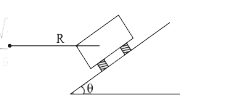A car is moving in a horizontal level circular track with uniform speed v. If R is the radius of circular path, then the minimum coefficient of friction to avoid over turning is
To solve the problem of finding the minimum coefficient of friction required to avoid overturning for a car moving in a horizontal circular track, we can follow these steps:
1. Understand the Forces Acting on the Car:
- When a car moves in a circular path, it experiences a centripetal force that keeps it in that path. This force is provided by the friction between the tires and the road.
- The weight of the car (mg) acts downwards, and the normal force (N) acts upwards.
2. Identify the Centripetal Force:
- The required centripetal force (Fc) to keep the car moving in a circle is given by the formula:
Fc=mv2R
where:
- m = mass of the car
- v = speed of the car
- R = radius of the circular path
3. Static Friction as Centripetal Force:
- The static friction (f) provides the necessary centripetal force to prevent the car from skidding. Thus, we can write:
f=μN
where:
- μ = coefficient of static friction
- N = normal force
4. Normal Force Calculation:
- On a level surface, the normal force is equal to the weight of the car:
N=mg
5. Setting Up the Equation:
- Substituting the expression for normal force into the friction equation gives us:
μmg=mv2R
6. Canceling Mass (m):
- Since mass m appears on both sides of the equation, we can cancel it out:
μg=v2R
7. Solving for Coefficient of Friction (μ):
- Rearranging the equation to solve for μ gives:
μ=v2Rg
Final Answer:
The minimum coefficient of friction (μ) required to avoid overturning is:
μ=v2Rg
- When a car moves in a circular path, it experiences a centripetal force that keeps it in that path. This force is provided by the friction between the tires and the road.
- The weight of the car (mg) acts downwards, and the normal force (N) acts upwards.
- The required centripetal force (Fc) to keep the car moving in a circle is given by the formula:
Fc=mv2R
where:
- m = mass of the car
- v = speed of the car
- R = radius of the circular path
- The static friction (f) provides the necessary centripetal force to prevent the car from skidding. Thus, we can write:
f=μN
where:
- μ = coefficient of static friction
- N = normal force
- On a level surface, the normal force is equal to the weight of the car:
N=mg
- Substituting the expression for normal force into the friction equation gives us:
μmg=mv2R
- Since mass m appears on both sides of the equation, we can cancel it out:
μg=v2R
- Rearranging the equation to solve for μ gives:
μ=v2Rg
The minimum coefficient of friction (μ) required to avoid overturning is:
μ=v2Rg
Topper's Solved these Questions
- LAWS OF MOTIONBOOK - AAKASH INSTITUTE ENGLISHCHAPTER - LAWS OF MOTIONEXERCISE - Assignment (SECTION-A)
65 Videos
- LAWS OF MOTIONBOOK - AAKASH INSTITUTE ENGLISHCHAPTER - LAWS OF MOTIONEXERCISE - Assignment (SECTION-B)
44 Videos
- LAWS OF MOTIONBOOK - AAKASH INSTITUTE ENGLISHCHAPTER - LAWS OF MOTIONEXERCISE - Example
24 Videos
- KINETIC THEORYBOOK - AAKASH INSTITUTE ENGLISHCHAPTER - KINETIC THEORYEXERCISE - EXERCISE (ASSIGNMENT) SECTION - D Assertion - Reason Type Questions
10 Videos
- MAGNETISM AND MATTER BOOK - AAKASH INSTITUTE ENGLISHCHAPTER - MAGNETISM AND MATTER EXERCISE - ASSIGNMENT (SECTION D)
26 Videos
Similar Questions
A car is moving in a horizontal level of circular track with uniform speed of 10ms. If radius of circular path is 50 m then the minimum coefficient of friction to avoid over turning is
View SolutionA particle is moving around a circular path with uniform angular speed (x) . The radius of the circular path is (r). The acceleration of the particle is:
View SolutionA particle moves in a circular path with a uniform speed. Its motion is
View SolutionA car moving around a circular track with uniform speed is in …………...…….(non-uniform motion/uniform motion).
View SolutionA car of maas M is moving on a horizontal circular path of radius r. At an instant its speed is v and is increasing at a rate a.
View SolutionA car is moving in a circular path with a uniform speed v. Find the magnitude of change in its velocity when the car rotates through an angle θ.
View SolutionA particle of mass 'm' is moving on a circular path of radius 'r' with uniform speed 'v'. Rate of change of linear momentum is
View SolutionA particle of mass m is moving on a circular path of radius r with uniform speed v , rate of change of linear momentum is
View SolutionA car is moving on a circular road which is rough and banked at angle . If radius of circular track is R then. Choose correct statement:

View SolutionA car is moving on a horizontal circular track of radius 0.2 km with a constant speed. If coefficient of friction between tyres of car and road is 0.45, then maximum speed of car may be [Take g=10m/s2]
View Solution
